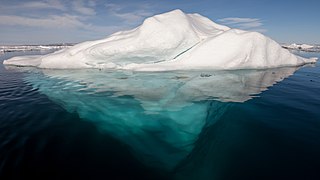 W
WDe-icing is the process of removing snow, ice or frost from a surface. Anti-icing is understood to be the application of chemicals that not only de-ice but also remain on a surface and continue to delay the reformation of ice for a certain period of time, or prevent adhesion of ice to make mechanical removal easier.
 W
WIce protection systems are designed to keep atmospheric ice from accumulating on aircraft surfaces, such as wings, propellers, rotor blades, engine intakes, and environmental control intakes. If ice is allowed to build up to a significant thickness it can change the shape of airfoils and flight control surfaces, degrading the performance, control or handling characteristics of the aircraft. An ice protection system either prevents formation of ice, or enables the aircraft to shed the ice before it can grow to a dangerous thickness.
 W
WAn ice road is a winter road, or part thereof, that runs on a naturally frozen water surface in cold regions. Ice roads allow temporary transport to isolated areas with no permanent road access. They reduce transportation cost of materials that otherwise would ship as expensive air freight, and they allow movement of large or heavy objects for which air freight is impractical.
 W
WIce Road Truckers is an American reality television series that premiered on History Channel, on June 17, 2007. It features the activities of drivers who operate trucks on seasonal routes crossing frozen lakes and rivers, in remote Arctic territories in Canada and Alaska. Seasons 3–6 also featured Alaska's improved but still remote Dalton Highway, which is mainly snow-covered solid ground. The newest seasons are mainly focused on Manitoba's winter roads. The series' eleventh season finished airing on November 9, 2017.
 W
WAn ice scraper is a handheld tool for removing frost, ice, and snow from windows, usually on automobiles. Basic scrapers have a plastic blade and handle, though some have blades made out of metal. More complex models often include brushes to help remove collected snow, or squeegees to remove water if the ambient temperature is near the melting point. Alternatively, the handle can be inside a glove-like enclosure to help keep the user's hands warm and dry when using the scraper.
 W
WAn iceberg is a large piece of freshwater ice that has broken off a glacier or an ice shelf and is floating freely in open (salt) water. Small bits of disintegrating icebergs are called "growlers" or "bergy bits".
 W
WIn aviation, icing conditions are atmospheric conditions that can lead to the formation of water ice on an aircraft. Ice accretion can affect the external surfaces of an aircraft – in which case it is referred to as airframe icing – or the engine, resulting in carburetor icing, air inlet icing or more generically engine icing. These phenomena do not necessarily occur together. Both airframe and engine icing have resulted in numerous fatal accidents in aviation history.
 W
WThe International Ice Patrol is an organization with the purpose of monitoring the presence of icebergs in the Atlantic and Arctic Oceans and reporting their movements for safety purposes. It is operated by United States Coast Guard but is funded by the 13 nations interested in trans-Atlantic navigation. As of 2011 the governments contributing to the International Ice Patrol include Belgium, Canada, Denmark, Finland, France, Germany, Greece, Italy, Japan, the Netherlands, Norway, Panama, Poland, Spain, Sweden, the United Kingdom, and the United States.
 W
WKite ice skating, sometimes referred to as para-skating or para ice skating, is an ice-based sport using a large controllable kite to propel ice skaters across frozen rivers, frozen lakes and other frozen surfaces. With a traditional diamond-shaped kite it's quite possible to go much faster than the wind speed by angling the kite much as a sailboat can trim its course and sails for greater speed. In fact, it's possible to exceed safe speeds quite easily, leaving one's legs exhausted from absorbing the shock of bumpy ice and becoming susceptible to spectacular crashes. On a gusty winter day one spends considerable time raising the kite in the air parallel to the ice to slow down somewhat.
 W
WThe National Ice Center (NIC) is a tri-agency operational center whose mission is to provide worldwide navigational ice analyses for the armed forces of the United States, allied nations, and U.S. government agencies.
 W
WAn ice pier is a man-made structure used to assist the unloading of ships in Antarctica. It is constructed by pumping seawater into a contained area and allowing the water to freeze. By repeating this procedure several times, additional layers are built up. The final structure is many metres in thickness, and strong enough to support container trucks. Operation Deep Freeze personnel constructed the first floating ice pier at Antarctica’s southernmost sea port at McMurdo Station in 1973. Ice piers have been in use each summer season since, at McMurdo's natural harbor at Winter Quarters Bay located at 77°50′S 166°40′E. The harbor is positioned on the southern tip of Ross Island.
 W
WIce rafting is the transport of various materials by ice. Various objects deposited on ice may eventually become embedded in the ice. When the ice melts after a certain amount of drifting, these objects are deposited onto the bottom of the water body, e.g., onto a river bed or an ocean floor. These deposits are called ice rafted debris (IRD) or ice rafted deposits. Ice rafting was a primary mechanism of sediment transport during glacial episodes of the Pleistocene when sea levels were very low and much of the land was covered by large masses (sheets) of ice. The rafting of various size sediments into deeper ocean waters by icebergs became a rather important process. Ice rafting is still a process occurring today, although its impact is significantly less and much harder to gauge.
 W
WKaj Antero Riska is a naval architect and engineer with expertise in ice and arctic technology. He has written various publications about ice-going ships and icebreaker design, ice loads and ice management for arctic offshore floating platforms. He is now working at Total S.A. as Senior Ice Engineer.
 W
WThe Salt Belt is the U.S. region in which road salt is used in winter to control snow and ice. States in the salt belt include Connecticut, Delaware, Illinois, Indiana, Iowa, Kansas, Kentucky, Maine, Maryland, Massachusetts, Michigan, Minnesota, Missouri, Nebraska, New Hampshire, New Jersey, New York, North Dakota, Ohio, Pennsylvania, Rhode Island, Vermont, Virginia, West Virginia, Wisconsin, and Washington DC. Other states such as Montana, Wyoming, Colorado, Idaho and Utah are also considered part of the Salt Belt but use less corrosive substances.
 W
WSkate sailing is a sport moving over ice standing on ice skates utilizing the force of the wind. A small sail is held in ones hands or leaned against with the whole body. Using a metal blade under foot and the height of the ice skates is of much importance in being able to steer as much it is acquiring the technique to gain an edge.
 W
WA snow road is a type of winter road, which is a road that is used or trafficable only in the winter. Snow roads make up some or all of the on-land segments of a winter road. The snow is either compacted in place or, when there is not enough of it, is hauled from elsewhere, then compacted. The snow may be processed, for instance, by agitation to reduce the size of the particles before compaction. Additional snow is also used to help protect the vegetation and as a means of improving trafficability. This snow, sometimes referred to as 'snow pavement', can be compacted to various level, depending on requirements and available equipment – a higher compaction will accommodate heavier vehicles and higher tire pressures.
 W
WSnow tires, also known as winter tires, are tires designed for use on snow and ice. Snow tires have a tread design with larger gaps than those on conventional tires, increasing traction on snow and ice. Such tires that have passed a specific winter traction performance test are entitled to display a "Three-Peak Mountain Snow Flake" symbol on their sidewalls. Tires designed for winter conditions are optimized to drive at temperatures below 7 °C (45 °F). Some snow tires have metal or ceramic studs that protrude from the tire to increase traction on hard-packed snow or ice. Studs abrade dry pavement, causing dust and creating wear in the wheel path. Regulations that require the use of snow tires or permit the use of studs vary by country in Asia and Europe, and by state or province in North America.